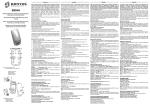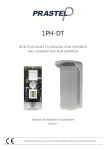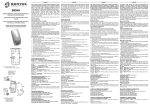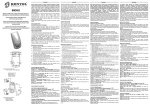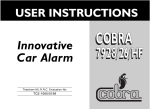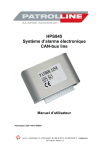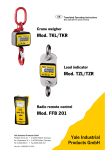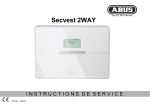Download HP S 845 (H)
Transcript
HPS 845 (H) USER MANUAL C A N B U S / A n a l o g C a r a l a r m a n d a n t i h i - j a c k s y s t e m , w i t h a d d i t i o n a l P A T R O L L I N E r e m o t e c o n t r o l s November 2010. Operation with default remote control ALARM ARMING Push closing button of default remote control of the vehicle. The arming will be confirmed by the followings: Blinker flashing based on closing features of the vehicle 1 beep (if it is programmed) Switching ON of the LED on the dashboard Activation of electric engine immobilization (if it was connected) Activation of module outputs (optional ultrasonic sensors, hyperfrequency etc.) The CDL closes the doors ALARM DISARMING Push opening button of default remote control of the vehicle. The disarming will be confirmed by the followings: 2 beeps (if it is programmed) Switching OFF of the LED on the dashboard Deactivation of electric engine immobilizer (if it was connected) Deactivation of module outputs (optional ultrasonic sensors, hyperfrequency etc.) The CDL opens the doors Blinker flashing based on opening features of the vehicle November 2010. Operation with optional PATROLLINE remote control ALARM ARMING Push closing button, Nr. 3 of the PATROLLINE remote control. The arming will be confirmed by the followings: Blinker flashing (if it is programmed) 1 beep (if it is programmed) Switching ON of the LED on the dashboard Activation of electric engine immobilization (if it was connected) Activation of module outputs (optional ultrasonic sensors, hyperfrequency etc.) The CDL closes the doors (if the alarm was connected to it) ALARM DISARMING Push opening button, Nr. 1 of the PATROLLINE remote control. The disarming will be confirmed by the followings: 2 beeps (if it is programmed) Switching OFF of the LED on the dashboard Deactivation of electric engine immobilization (if it was connected) Deactivation of module outputs (optional ultrasonic sensors, hyperfrequency etc.) The CDL opens the doors (if the alarm was connected to it) Blinker flashing (if it is programmed) Special functions of PATROLLINE remote control The HPS 845 (H) device defaulty doesn’t contain remote controls, maximum 4 pieces PATROLLINE remote control can be memorized only optionally. The PATROLLINE remote controls use 2,4 GHz technology uniquely in Europe. Thanks to this innovative technology, the PATROLLINE remote controls with the alarm are able for 2 ways communication. Therefore it is possible that with special application of the remote control buttons you can control the last did procedure. Unique application of the 2 ways communication provides the opportunity that different feedbacks of the remote control LED show, that the connection created or not between the remote control and the alarm: - LED is fix ON: If each button of the remote control was used, the LED of the remote control is fix ON, showed that the alarm discovered the remote control. November 2010. - LED flashes quickly: If the distance is too big between the alarm and the remote control, and the alarm doesn’t sense the remote control signal at pushing of each button, the LED flashes quickly. - LED 4 slow flashings: If you have to change battery in the remote control, after pushing of each button the LED immediately flashes 4. With help of the PATROLLINE remote control you can check that the car alarm was armed, or it is in disarmed status. (You can check the alarm status only with that PATROLLINE remote control, with which the alarm was disarmed or armed latest!) Push Nr. 1 (opening) and Nr. 3 (closing) button of the remote control in same time, by this time LED of the remote control signs armed or disarmed status of the alarm in big distance too from the car: - LED flashes quickly: The alarm was armed with this PATROLLINE remote control. - LED is OFF: The alarm was disarmed with this PATROLLINE remote control. Neutral time, armed status After the alarm was armed with the default (OEM) remote control or with the PATROLLINE remote control, the alarm will arm in the next 10 seconds, what signaled by the fixed light of the LED. During this time, if each sensor will be tested, the alarm will sign it with blinker flashing (number of the blinker flashing shows cause of the triggering, as table shows it in “Alarm memory” paragraph.) The flashing of the LED on the dashboard will indicate that the system is ready to react with acousticoptic signal for triggering cause. Triggering After the inhibition time, the alarm will be in armed status. The alarm will react with optic-acoustic signal for triggering event, it will make to operate the horn, or siren and it will make to flash the blinkers. Time of the triggering cycle is 30 seconds. To stop the triggering without disarming of the alarm, push Closing button of the default remote control or Nr. 2 (panic) button of the PATROLLINE remote control! To stop the triggering and disarming of the alarm, push Opening button of the default remote control or Nr. 1 (opening) button of the PATROLLINE remote control! November 2010. Panic triggering After the inhibition time, if Nr. 2 (panic) button of the PATROLLINE remote control or closing button of the default remote control was pushed, the alarm will trigger till 30 seconds (beep/acoustic signal). Warning! You have to activate the panic function to operate it. Ask help of the installer to the activation! Ultrasonic/Hyperfrequency/Default shock sensor exclusion This function is necessary, if you can leave dogs or cats in the car without triggering of the alarm. In active status of the function, other senses of the alarm operate, just the interior protection and the default shock sensor don’t operate. After locking, during inhibition time, push closing button of the default or PATROLLINE remote control to switch OFF operation of the ultrasonic / hyperfrequency / default shock sensor. The alarm signs exclusion of the ultrasonic / hyperfrequence / default shock sensor with 3 blinker flashings and 3 beeps. Default shock sensor exclusion with optional PATROLLINE remote control This function is that the alarm doesn’t trigger for vibrations concern the car. In active status of the function other senses of the alarm operate, just the default shock sensor doesn’t operate. After locking, during inhibition time, push Nr. 2 and 3 button of the PATROLLINE remote control in same time to switch OFF the default shock sensor. The alarm signs exclusion of the shock sensor with 5 blinker flashings and 5 beeps. Warning! This function is usable only with the optional PATROLLINE remote control, not with default remote control of the car! Operation with optional wireless opening sensor Optional PATROLLINE wireless opening sensors can be memorized for the HPS 845 (H) device. With help of them opening sensation of buildings (e.g. garage), or door of campers can be solved in near of the vehicle, in which HPS 845 (H) device is installed. In case of cracking of the garage door or camper door, HPS 845 alarm installed into the vehicle will trigger. These sensors can be memorized in 2 safety zones of the HPS 845 (H) alarm: maximum 24 pieces in zone 1., maximum 8 pieces in zone 2. Difference between the two zones is that sensors memorized in zone 2. (similar to the ultrasonic) can be disarmed temporarily with twice pushing of closing button of the remote controls. Exclusion of siren With help of the default remote control and the PATROLLINE remote control too it is possible to be excluded the horn or siren function. In case of usage of default remote control: At disarmed alarm (CDL opened), turn ON and OFF the ignition key for 3 times and, within 30 seconds, push the default remote control to close the CDL. November 2010. At this time, the central unit will sign the attempt to break in by the flashing of the blinkers only. IGNITION KEY On Off On Off On Off With CDL open (LED off) 1st time 2nd time 3rd time Push the original remote control to close the doors within 30 seconds In case of usage of PATROLLINE remote control: After arming of the alarm, within the 10 seconds inhibition time, push Nr. 2 button of the PATROLLINE remote control, from this time, the device signs the triggering only with the blinker flashing. 4 beeps and 4 blinker flashings will confirm the exclusion. Warning! The siren exclusion is valid for only one triggering cycle! If you switch OFF the alarm with the default or PATROLLINE remote control, the system will be restored automatically in original state, and for the next arming it will react with beep and acoustic signals for every triggering causes. Automatic rearming If the alarm was disarmed with default remote control of the vehicle, but the doors didn’t open, within 15 seconds the CDL closes back automatically the doors, and in same time the alarm switches ON. Warning! In those cars, in which there isn’t automatic CDL closing back function, ask the installer to program automatic rearming function of the alarm! If it is programmed, automatic rearming function of the alarm will operate, but the CDL will close, if the alarm was connected for it at installation! After programming automatic rearming function of the alarm, this function will operate with the optional PATROLLINE remote controls too according to the above mentioned! Status memory If the armed alarm is disconnected from its connector, after the reconnection it will stay in armed status, protected the car further. Anti hi-jack function The alarm can immobilize the engine while the engine is ON when somebody hijack the car. This function is disarmed defaulty. Arming of this function can happen based on request of the client in writing. To arming of the function, please contact with the installer. November 2010. Antiagression function The alarm can immobilize the engine when somebody hijacks the car together with its own keys. This function is disarmed defaulty. Arming of this function can happen based on request of the client in writing. To arming of the function, please contact with the installer! Alarm memory If the central unit records one or more triggering causes, after disarming of the alarm, it will show the triggering cause at opening of the driver’s door, or at pushing of the anti hi-jack button, through the LED. To verify type of triggering, check number of flashings of the LED with the table below. CAUSE N. flashings of the LED 1 DOORS OPENING (WITH CAN-BUS SIGNAL) AND TRIGGERING BY ADDITIONAL INPUT (BLUE/WHITE WIRE INPUT) 2 DRIVER’S DOOR OPENING WITH MECHANICAL KEY (WITH CAN-BUS SIGNAL) 3 BONNET OPENING (WITH CAN-BUS SIGNAL) 4 TRUCK OPENING (WITH CAN-BUS SIGNAL) 5 IGNITION PROTECTION (WITH CAN-BUS SIGNAL, OR THROUGH THE GREEN/BLACK WIRE) 6 SHOCK SENSOR 7 ULTRASONIC SENSOR 8 ADDITIONAL INPUT (BLUE WIRE) 9 ADDITIONAL SENSOR (BLUE/RED WIRE INPUT) 12 RADIO OPENING SENSOR, OR MOVING SENSOR 13 BONNET OPENING (WITH ANALOG SIGNAL) 14 GAS SENSOR 15 RADIO FREQUENCY DISTURBING November 2010. Safety function Door protection Engine block Shock sensor Ignition protection Ultrasonic Anti hi-jack Antiagression Senses door, trunk and bonnet opening Prevents starting of the engine of the car Senses the broke of the door’s window Senses the ignition of the car Option! Sense moving in the passenger compartment Triggers in case of running engine, and it can block the engine, if somebody steal the car Triggers at starting of the car with its own key and it can block the engine, if somebody wants to steal the car PIN code The PIN code is for that the user can switch OFF the alarm, if the remote control or the alarm get wrong or the battery discharged in the remote control. PIN code emergency switching OFF function of the alarm, dependent on alarm programming, has 3 types operating opportunities, which are the followings: 1. 2. 3. PIN code emergency switching OFF with ignition key (it is default setting of the alarm). PIN code emergency switching OFF with usage of brake pedal/hand brake (this function can be used after programming of the alarm). PIN code emergency switching OFF on ignition key ON, automatically (this function can be used after programming of the alarm). In all boxes of the alarms can be found an envelop, which contains the secret PIN code. Only the user can open this envelop. Every alarm has different PIN code! We suggest for the user as for the perfect safety to change the original set PIN code for a new, own one. Please follow the next instructions in the followings chapters. If you have got any further problem with the PIN code, please look for only your importer! Open only by the USER!!! November 2010. Usage of the PIN code is necessary, when the remote control lost, or the battery was flat, or the alarm went wrong, but the device is in switched ON status. Dependent on equipment of the cars, it can be necessary to change the PIN code emergency switching OFF operation, for example in that case, if the vehicle is equipped with “START & GO” system, by this time we suggest to program the alarm for the 2. or 3. emergency switching OFF operating mode instead of the default setting of the PIN code emergency switching OFF function! Only importer of PATROLLINE and his contracted partners can do the programming of the alarm, because special software and hardware is necessary to it! 1. PIN code emergency switching OFF with ignition key (it is default setting of the alarm) The PIN code is a 3-figures number (e.g. 1-2-3). If you would like to use the PIN code, do the following instructions with ignition key of the vehicle: At armed alarm, open the driver’s door with mechanical key. The alarm starts trigger, by this time turn ON the ignition key, and turn OFF the ignition key as many time as first digit of the PIN code. During turn ON the ignition key the LED is ON, after the first digit you have to wait to switch OFF the LED. After that immediately turn ON and OFF the ignition key as many time as the second digit. After the LED switching OFF, turn ON and OFF the ignition key as many time as the third digit. If the procedure was successful, the alarm switches OFF. If the procedure was unsuccessful, the alarm stays in armed status, and triggers, by this time you have to restart the PIN code emergency switching OFF procedure from first digit giving of the PIN code. 2. PIN code emergency switching OFF with usage of brake pedal/hand brake (this function can be used after programming of the alarm) At armed alarm, open the driver’s door with mechanical key. The alarm starts trigger, by this time turn ON the ignition key, and push/draw the brake pedal/hand brake as many time as first digit of the PIN code (the brake pedal/hand brake operate with CAN-BUS signals not in every car types, therefore they can’t be used for PIN code emergency switching OFF not in every cars!) During push/draw of the brake pedal/hand brake the LED is ON, after the first digit you have to wait to switch OFF the LED. After that immediately push/draw the brake pedal/hand brake as many time as the second digit. After the LED switching OFF push/draw the brake pedal/hand brake as many time as the third digit. If the procedure was successful, the alarm switches OFF. If the procedure was unsuccessful, the alarm stays in armed status, and triggers, by this time you have to restart the PIN code emergency switching OFF procedure from first digit giving of the PIN code. 3. PIN code emergency switching OFF on ignition key ON, automatically (this function can be used after programming of the alarm) At armed alarm, open the driver’s door with mechanical key. The alarm starts trigger, by this time turn ON the ignition key, and the transponder identifies the default key, and through the CAN-BUS network, the alarm will be disarmed automatically. November 2010. WARNING! If the Antitheft / Antiagression function are programmed, before starting of the procedure, push the secret button used to the Antitheft / Antiagression, and keep it pushed until the procedure wasn’t finished! Modification of the PIN code Modification of the PIN code is necessary if the client wants to modify the default PIN code for a personalized PIN code. Warning! We suggest to user of the product to modify the default PIN code for a new, personalized PIN code. To modify the PIN code, do the following instructions with ignition key of the vehicle: At disarmed alarm, turn ON and OFF the ignition key as many time as first digit of the PIN code. During turn ON the ignition key the LED is ON and after the first digit you have to wait to switch OFF the LED. After that immediately turn ON and OFF the ignition key as many time as the second digit. After the LED switching OFF, turn ON and OFF the ignition key as many time as the third digit. After that the LED flashes some times. Turn ON and OFF the ignition key as many time as first digit of the new PIN code while the LED flashes. During turn ON the ignition key the LED is ON and after the first digit you have to wait to switch OFF the LED. After that immediately turn ON and OFF the ignition key as many time as second digit of the new PIN code. After the LED switching OFF, turn ON and OFF the ignition key as many time as third digit of the new PIN code. If the procedure was successful, the LED signs it with quick flashing. After that only the new PIN code is usable! If PIN code function of the alarm was programmed for brake pedal/hand brake mode, you have to do the above procedure on same way, only you have to push/draw the brake pedal/hand brake instead of turn ON/OFF the ignition key! WARNING! If the Antitheft / Antiagression function are programmed, before starting of the procedure, push the secret button used to the Antitheft / Antiagression, and keep it pushed until the procedure wasn’t finished! Valet function This function is, that during service of the vehicle, operating functions of the alarm are suspension. Usage of the valet function has, independently from programming of the alarm, 3 types operating opportunities, which are the followings: November 2010. 1. Valet function with anti hi-jack button. 2. Valet function with ignition key. 3. Valet function with usage of brake pedal/hand brake (this function can be used after programming of PIN code emergency switching OFF function of the alarm). 1. Valet function usage with anti hi-jack button: Activation of the valet function: At disarmed alarm, sit into the car. All doors of the vehicle have to be closed! Turn ON the ignition key and immediately push and keep pushed anti hi-jack button of the alarm, what was installed into the vehicle. After 10 seconds LED of the alarm on the dashboard starts trigger and it flashes till 5 seconds. Till the LED flashes, let off the anti hi-jack button! By this time the LED flashes twice slowly, signed arming of the valet function. If you let off the anti hi-jack button too early or too late, you have to start the procedure from starting! Deactivation of the valet function: At disarmed alarm, sit into the car. All doors of the vehicle have to be closed! Turn ON the ignition key and immediately push and keep pushed anti hi-jack button of the alarm, what was installed into the vehicle. After 10 seconds LED of the alarm on the dashboard starts trigger and it flashes till 5 seconds. Till the LED flashes, let off the anti hi-jack button! By this time the LED flashes four times slowly, signed disarming of the valet function. If you let off the anti hijack button too early or too late, you have to start the procedure from starting! To remind activated status of the valet function, the LED will flash continuously twice if you turn ON the ignition key. 2. Valet function usage with ignition key (this function operates too, if the PIN code emergency switching OFF function is programmed for the 3. operating opportunity, for the PIN code emergency switching OFF on ignition ON, automatically operation): Activation of the Valet function: At disarmed alarm, turn ON and OFF the ignition key as many time as first digit of the PIN code of the alarm. During turn ON the ignition key the LED is ON, and after the first digit you have to wait to switch OFF the LED. After that immediately turn ON and OFF the ignition key as many time as the second digit. Deactivation of the Valet function: Turn ON and OFF the ignition key as many time as first digit of the PIN code of the alarm. During turn ON the ignition key the LED is ON, and after the first digit you have to wait to switch OFF the LED. After that immediately turn ON and OFF the ignition key as many time as the second digit. November 2010. After the LED switching OFF, turn ON and OFF the ignition key as many time as the third digit. The LED flashes some times signed arming of the valet function. After the LED switching OFF, turn ON and OFF the ignition key as many time as the third digit. After that the valet function will be in disarmed status. To remind activated status of the valet function, the LED will flash continuously twice if you turn ON the ignition key. 3. Valet function usage with brake pedal/handbrake (this function operates too, if the PIN code emergency switching OFF function is programmed for the 2. operating opportunity, for the PIN code emergency switching OFF with usage of brake pedal/hand brake operation): Activation of the Valet function: At disarmed alarm, turn ON the ignition key, and push/draw the brake pedal/hand brake as many time as first digit of the PIN code (the brake pedal/hand brake operate with CAN-BUS signals not in every car types, therefore they can’t be used for valet function not in every cars!) During push/draw of the brake pedal/hand brake the LED is ON, after the first digit, you have to wait to switch OFF the LED. After that immediately push/draw the brake pedal/hand brake as many time as the second digit. After the LED switching OFF push/draw the brake pedal/hand brake as many time as the third digit. The LED flashes some times, signed arming of the valet function. Deactivation of the Valet function: Turn ON the ignition key, and push/draw the brake pedal/hand brake as many time as first digit of the PIN code. During push/draw of the brake pedal/hand brake the LED is ON, after the first digit, you have to wait to switch OFF the LED. After that immediately push/draw the brake pedal/hand brake as many time as the second digit. After the LED switching OFF push/draw the brake pedal/hand brake as many time as the third digit. After that the valet function will be in disarmed status. To remind activated status of the valet function, the LED will flash continuously twice if you turn ON the ignition key. WARNING! If the Antitheft / Antiagression function are programmed, before starting of the procedure, push the secret button used to the Antitheft / Antiagression, and keep it pushed until the procedure wasn’t finished! (except the „1. Valet function with antitheft button” mode)! Alarm maintenance Our alarms are sophisticated systems. The reliability as well as time life may be furthermore incremented just adopting some precautions such as: November 2010. Battery changing: Open box of the remote control, remove the old battery, and put the new. Take into consideration the polarity, what is located on side of the battery. Use litium battery (CR 2032 in case of the optional PATROLLINE remote control). Suggested the battery changing in every 2. years. Vehicle cleaning: should you clean the vehicle via high-pressure beams (hydro beam or similar), please protect the siren prior to commence cleaning. The alarm warranty will be cancelled if water is detected into the alarm. Main maintenance: All repairs must be carried at PATROLLINE assistance centers. Alarm systems pampering by non authorized personnel may invalidate alarm feasibility as well as your vehicle safety. Declaration of conformity This product harmonizes with the followings: E/ECE/324 E/ECE/TRANS/505 Regulation No. 116 >> Rev.2/Add.115 European Directive, so it satisfies all the requirements asked about the functionality of the alarm devices, and for the electromagnetic compatibility. The installation certificate of the alarm, included in the box, must be properly filled in every section and it will be part of the documentation of the vehicle. It is required to write the following homologation number on the installation certificate to complete the conformity with the directive. E24 116R A-000031 Note: Patrolline Kft 8000 Székesfehérvár, Királysor 30. Tel/Fax: +36/22-317-367, +36/22-503-078 E-mail: [email protected] Web: www.canbusriaszto.hu, www.patrolline.eu November 2010.
















